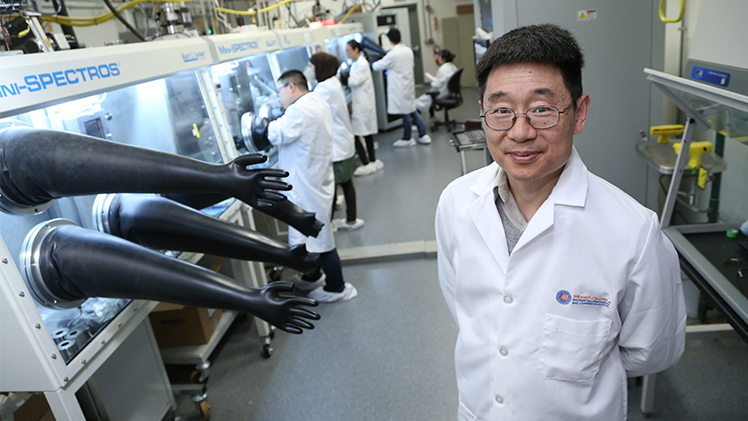A team of scientists from The University of Toledo, Northwestern University and the University of Toronto collaborated to create an all-perovskite tandem solar cell with extremely high efficiency and record-setting voltage when converting sunlight into electricity.
Introduced to the world in a research paper published in the journal Nature, the new solar cell produced without silicon demonstrates the potential of this emerging photovoltaic technology to overcome key limits associated with traditional, industry-standard silicon-based solar cells, while also offering a lower manufacturing cost.

Dr. Yanfa Yan, Distinguished University Professor of Physics, is part of an international team of scientists who produced a high-performing solar cell without silicon.
Powering the transition to a cleaner energy future, the researchers from the U.S. and Canada used two different layers of perovskite, each tuned to a different part of the solar spectrum, to produce what is known as a tandem solar cell.
It is more efficient than silicon.
UToledo’s contribution to the project was the development of a high-voltage narrow gap subcell used in the tandem solar cell.
“The advancement of this work is the realization of open-circuit voltage of 2.19 electron volts, which is a record for all-perovskite tandem solar cells,” said Dr. Yanfa Yan, Distinguished University Professor of Physics at UToledo and member of the UToledo Wright Center for Photovoltaics Innovation and Commercialization who has been pushing the performance of perovskites for 10 years in the hopes of developing the next-generation solar panel for the consumer market.
The new solar cell’s power-conversion efficiency reached 27.4%, which also breaks the current record for traditional silicon solar cells.
A tandem solar cell combines a wide band gap subcell, which absorbs well in the ultraviolet part of the spectrum as well as some visible light, and narrow band gap subcell, which is tuned more toward the infrared part of the spectrum. Open-circuit voltage of a tandem cell depends on the open-circuit voltages of both subcells.
“Between the two, we cover more of the spectrum than would be possible with silicon,” said Dr. Chongwen Li, a UToledo alumnus who graduated in 2020 with a Ph.D. in physics and now a postdoctoral researcher at the University of Toronto and one of five co-lead authors on the new paper.
Yan at UToledo is a leader in the development of thin-film solar cells including perovskite solar cell technology using a compound material with a special crystal structure that can be used to create less expensive and highly efficient solar cells.
“Further improvements in the efficiency of solar cells are crucial for the ongoing decarbonization of our economy,” said University of Toronto Engineering Professor Ted Sargent, a corresponding author of the research who recently joined the Department of Chemistry and the Department of Electrical and Computer Engineering at Northwestern University.
“While silicon solar cells have undergone impressive advances in recent years, there are inherent limitations to their efficiency and cost, arising from material properties. Perovskite technology can overcome these limitations, but until now, it had performed below its full potential. Our latest study identifies a key reason for this and points a way forward.”
The tandem design enables the cell to produce a very high open-circuit voltage, which in turn improves its efficiency. But the key innovation came when the team analyzed the interface between the perovskite layer, where light is absorbed and transformed into excited electrons, and the adjacent layer, known as the electron transport layer.
The team coated a substance known as 1,3-propanediammonium (PDA) onto the surface of the perovskite layer. Though the coating was only a few nanometres in thickness, it made a big difference in getting better energetic alignment of the perovskite layer with the electron transport layer.
The researchers will now focus on further enhancing efficiency by increasing the current that runs through the cell, improving stability and enlarging the area of the cell so that it can be scaled up to commercial proportions.
UToledo has been a trailblazer in solar energy research and development for three decades.
The Wright Center for Photovoltaics Innovation and Commercialization was created at UToledo in 2007 to support solar energy research and manufacturing with $18.6 million in support from the Ohio Department of Development, along with matching contributions of $30 million from federal agencies, universities and industrial partners.